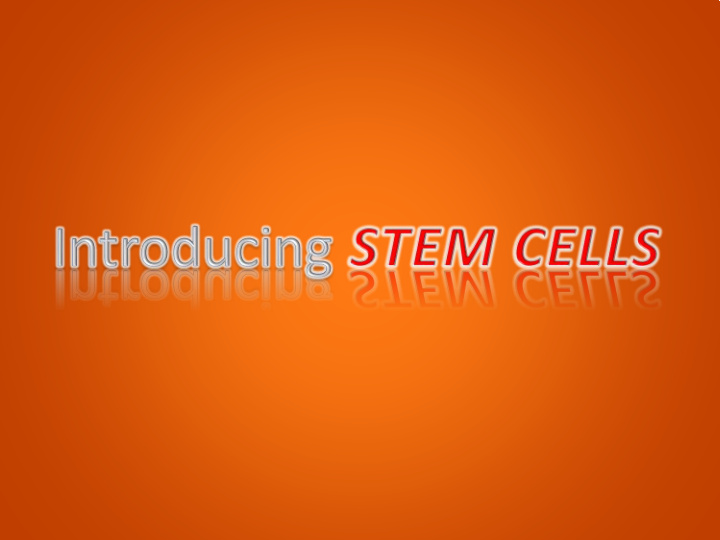



Any questions for a scientist? Ask your parents to email us! sarah.gundy@nuigalway.ie Unit 5A: Ke e ping He a lthy
Cells are like LEGO that “stick” together to make bigger things
Cells are the smallest building blocks that make up the body There are 3 types As a cell gets older of cells: it can lose the • Young Cells ability to change • Teenage Cells or regenerate • Grown Up Cells As a cell gets older it gets more defined and is “stuck” as a certain type of cell
Stem cells are special because: 1) They can copy themselves. (Not all cells can do this!) 2) They can make other types of cells. Our body uses stem cells to replace damaged or dead cells. We hope that we can use them in the future to treat diseases.
Regeneration is the ability of an animal's cells to make new body parts when they are an adult. A newt can regenerate an entire limb within 7-10 weeks For example, some animals can do more than just make new skin, they can grow new arms or even heads!
When an animal is developing, most of the cells turn into a particular type. Cells become blood cells, heart cells, bone cells, etc. During development, stem cells sometimes remain that do not turn into a type of cell. Some animals can use their stem cells to regenerate lost or damaged body parts. To do this, stem cells need to get the right signals from the rest of the body!
Hydractinia (also know as snail fur) is a small sea creature that lives on the shell of Hermit Crabs. Hydractinia can regenerate its head within 72 hours of being cut off.
Special genes get These signals cause Hydractinia have turned on and the stem cells to the correct genetic send signals to move to the area recipe for stem cells in the that needs regeneration. body. regeneration .
A stem cell can do one of two things: = = Turn into a specific type of cell Make copies of itself Once a stem cell differentiates, it generally loses its ability to self-renew!
Stem cell lineages are like Pokemon! Pichu Pikachu Raichu
Cartilage = A rubber-like tissue made of collagen and elastin that covers and protects the ends of bones at joints Transitory Articular Cartilage Chondrocyte Chondrocyte
Tendon = A band of tissue that connects muscle to bone Mesenchymal Tenoblast Tenocyte Stem Cell
Thrombocyte (Platelet) = A cell found in the blood involved in clotting to stop bleeding Hematopoetic Megakarocyte Thrombocyte Stem Cell
Skin = The outer protective covering of the body which has up to seven layers of tissue, including the epidermis Epidermal Stem Keratinocyte Keratinocyte Cell (Young) (Old)
Muscle = The tissue responsible for movement throughout the body from walking to pumping blood Myoblast Myoblast (Tube) Muscle
Myelin Sheath = An insulating layer surrounding the axon of neurons allowing signals to be transmitted quickly from the brain to the body Neural Stem Cell Glial Progenitor Cell Oligodendrocyte
Neuron = A cell that receives and transmits information in the brain. Neuronal Stem Neurocyte Neuron Cell
Bone = A living tissue containing blood vessels and cells which allow it to grow and repair itself Transitory Osteoblast Osteocyte Osteoblast
Get a partner Shuffle then deal half the cards to each player face down Player one reads out the value from a category from the top card The player with the highest value wins and gets all of the cards, and places them on the bottom of his/her pile The player with all of the cards at the end is the winner
There are 8 groups of cards Each group contains 3 steps of differentiation Take note of the different types of cells and what they specialise in Notice how the higher differentiated a cell is, the lower its self-renewing power Notice how the lower differentiated a cell is, the higher its self-renewing power
Send us a photo of you playing our STEMinator card game! Any questions for a scientist? Ask your parents to email us! sarah.gundy@nuigalway.ie Unit 5A: Ke e ping He a lthy
References: 1. Bradshaw et al ., eLife 2015; 4e05506 2. commons.wikimedia.org 3. goo.gl/images/aFplMG 4. goo.gl/images/CbYRk5 5. try.stem-kine.com/lf-1/ 6. www.youtube.com/watch?v=evH0I7Coc54 Sincere thanks to all of the researchers who gave lectures and generously gave their time throughout the course. A special thanks to Mikey Creane for helping develop the content of the slides and Uri Frank for images and videos of Hydractinia! Thanks also to all the participating teachers who very kindly shared ideas and resources.
This publication has emanated from research conducted with the financial support of Science Foundation Ireland (SFI) and is co-funded under the European Regional Development Fund under Grant Number 13/RC/2073. This project has been funded by the European Union Seventh Framework Programme under Marie Curie Initial Training Networks (FP7-PEOPLE-2012-ITN) and Grant Agreement Number 317304 (AngioMatTrain). This project has also been funded by the European Union Horizon 2020 Programme (H2020-MSCA-ITN-2015) under the Marie Skłodowska -Curie Innovative Training Networks and Grant Agreement Numbers 676408 (BrainMatTrain) and 676338 (Tendon Therapy Train).
Recommend
More recommend